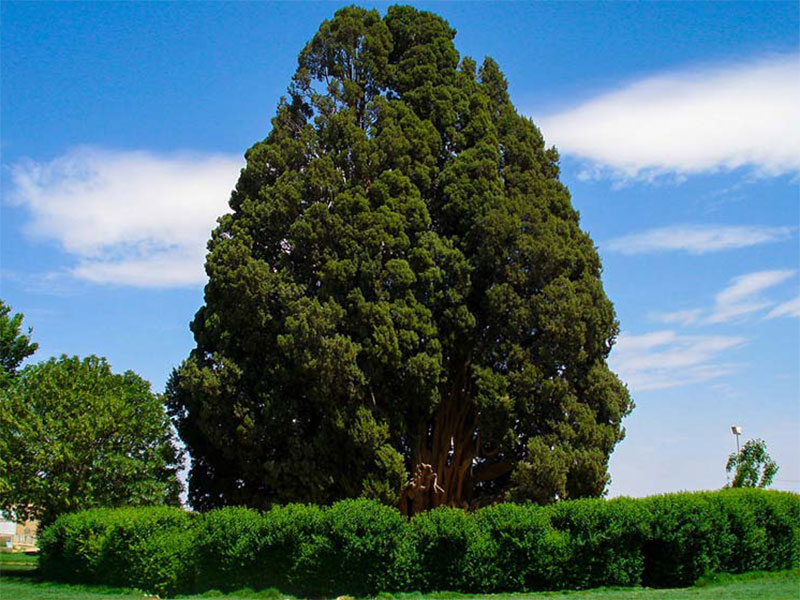
Are you interested to see one of the oldest trees in the world? The tree’s massive size and legendary history and age have made it one of the most popular attractions in the city of Abarkuh in Iran. This tree is estimated to be over 4500 years old and may be the oldest living treasure in Asia. In Zoroastrian culture, cypress has always had a special place in Iran because it is an evergreen tree, and the 4500-year-old Abarkuh cypress can perfectly reflect that. Sarv-e Abarkuh is not just an ordinary cypress tree. Therefore, you need to pay it a visit during your travels to the great city of antiquity, Abarkuh.
Where Is Sarv-e Abarkuh located?
Abarkuh itself is an incredible place located on the once crossroads of the Silk Road and has many excellent houses and antiquity of over 4000 years. Sarv-e Abar-Kuh is protected by the Cultural Heritage Ministry of Iran as a national natural monument and is indeed a major tourist attraction. The reason for naming the cypress tree Abarkuh is because the tree is located in Abarkuh city in Yazd province. That is why it is known and registered by the same name. In Abarkuh city, you can find many more tourist attractions, and by visiting them, you can collect much more memories from your adventures.
The Antiquity of the Tree
Sarv-e Abarkuh, a gorgeous, solid, tall tree, still stands in its glory today. A Mediterranean cypress tree that has a height of 25 meters, with a width of 11.5 meters at its trunk and an 18-meter circumference. This tree embraces the earth with its magical roots. It is a great blessing that this tree has lived for thousands of years and that human beings can still enjoy watching it. In ancient Iran, planting a tree had great importance, as it shows in old paintings and monuments such as Achaemenian carvings in Persepolis. By their means, we can come to understand the great glory and history that lies within each and every curve of this magnificent tree.

Sarv-e Abarkuh, a gorgeous, solid, tall tree, still stands in its glory today!
The Roots of Cypress in Iranian Culture
In ancient Iran, planting a tree was considered a great act. Cypress is noticed in many related symbols and old Persian poetry. It can also be seen as a symbol of life and beauty in some Achaemenian sculptures. Cypresses usually have been the first chosen tree for Iranian gardens. In all the famous Persian gardens, this kind of tree plays a significant role in their design. In ancient Iranian tales, the origin of this tree is credited to Japheth, the child of Noah, while others believe Zoroaster, the Iranian prophet, had planted Sarv-e Abarkuh. Legends state that this tree has an unusual and mysterious soul that can continue living for thousands of years.
Characteristics of Sarv-e Abarkuh
Sarv-e Abarkuh has unique features by which it is distinguished. The tree has worldwide popularity, a magnificent tree that surprises all the visitors with its glory. Sarv-e Abarkuh is not only important for Iran, but it is also valuable for the world, and many scientists and people from different parts of the world are eager to visit it. The tree’s life span has been credited to favorable natural conditions of its region. The tree’s environment has changed these days. For instance, there were loads of pomegranates trees surrounding it in the past. Nowadays, with the expansion of cities and tourist and vehicle traffics, the tree’s territory seems to be in a greater need to be secured.
Safety of the Tree
Naturally, all ancient and historical landmarks need care and protection, just like the case with Sarv-e Abarkuh, and several activities have been done to protect the straight and heavy Cypress. There are fences all around the tree. People shouldn’t approach or touch it as when the soil hardened due to their footsteps, it won’t have a chance to absorb water, and it will also alter micro-organisms. The Cultural Heritage and Tourism Organization of Yazd has taken some steps, like killing insects, to guarantee that the tree keeps on living for the upcoming years. Some other moves have also been made to protect the tree, including keeping it away from pests and insects harm, checking the issues related to visiting and tourism necessities, natural enclosures around the tree under current conditions to decrease tree’s damage, utilizing a trained workforce to protect this national monument, and providing lightning protection.
Are you planning to travel to Iran and looking for some adventure? Check out our Iran Climbing & Trekking Tours, Iran Ski Tours, Iran Desert Tours & Iran Cycling Tours.
